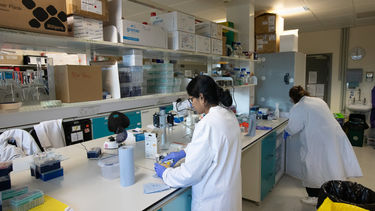Parkinsonās disease is a progressive neurological condition and the second most common neurodegenerative disease. Each day, 80 people in the UK are newly diagnosed with the disease, which affects over six million people globally. There is currently no cure or disease-modifying therapy.
Ā鶹ֱ²„appās Neuroscience Institute is an international centre of excellence that attracts considerable support from research councils, charities and industry partners. Close collaboration between scientists and doctors is a key strength. This bench-to-bedside approach is unique.
Facilities such as the Sheffield Institute for Translational Neuroscience (SITraN), the Sheffield NIHR Biomedical Research Centre (BRC) and advanced MRI-PET imaging technology (Sheffield Scanner) on campus also give the University the edge in developing new treatments, more quickly.
Our pioneering Parkinson's research has succeeded in establishing new disease models, uncovering disease mechanisms, identifying drug targets and promising candidates for a neuroprotective therapy to slow down or stop Parkinson's disease.
From trialling new treatments for Parkinsonās disease to launching a clinical support study group to support Parkinson's research across the UK, our researchers are studying Parkinsonās disease to gain a better understanding of what causes them and how to address them, while also working with patients to help assess and diagnose their condition then assemble a treatment plan.
The originality of our research
Professor Oliver Bandmann, Professor of Movement Disorders Neurology and Co-Director of the Neuroscience Institute said: āWe were the first institution worldwide to undertake a drug screen in Parkinsonās disease patient tissue: Rather than using artificial model systems, we took a skin biopsy from people with Parkinsonās, grew the cells in a dish and then assessed 2,000 compounds for their rescue effect on the cell batteries (the mitochondria). This helped us to identify a drug called ursodeoxycholic acid (UDCA) as a very promising drug for Parkinsonās. Our hope is that treatment with UDCA will slow down the worsening of Parkinsonās by rescuing the mitochondria which are often faulty in Parkinsonās.ā
āWe have now taken UDCA into a clinical trial called the UP study. Unique features of this trial includes state-of-the-art functional imaging (31P MR Spectroscopy) and the use of motion sensors to objectively quantify disease progression and how the disease responded to the drug. Some of the Parkinsonās patients included in the UP study are my own patients from Sheffield. Despite Covid, we completed the trial in November last year. We hope to have the study results soon!ā
āIn the future, it will be very important to have the right tools to choose the most promising drug for each individual patient. This is called āPersonalized Medicineā or āPrecision Medicineā, or known technically as ādisease stratificationā. We completed the most extensive tissue-based disease stratification project in Parkinsonās disease. This approach has allowed us to classifyā individual PwP according to the mechanism which caused ātheirā Parkinsonās disease. This will make it easier to put these patients on the right neuroprotective drug in the future! Many Parkinsonās patients from Sheffield and South Yorkshire have helped with these important biomarker studies - and so many of their spouses volunteered as healthy controls!ā
Co-owning a technology company, I was myself diagnosed with Parkinsonās over 5 years ago, and life has taken a very different path since then. Following involvement as a participant in the UP Ā鶹ֱ²„app (UDCA in Parkinsonās) at Sheffield, my ongoing curiosity (and clearly some self-interest!) regarding the wider field of related research led me to join the other Patient and Public Involvement (PPI) members within the growing UK Parkinsonās Disease Clinical Studies Group. Having a Parkinsonās diagnosis has resulted in many lifestyle changes with a focus on activities promoting physical and mental health playing a key role, even resulting in a competitive (if somewhat less competitive) return to sport.
Richard Walker
Postgraduate student undertaking a MSc in Neuroscience & Neurodegeneration at SITraN
I have worked in Parkinson's research for the last 23 years. I first became interested in Parkinson's research after one lecture I had as an undergraduate on Parkinson's which made clear all the advances which had been made in our understanding however this had not been translated to the clinic, I hence set out on a mission to research in this area at the forefront of translate laboratory research to the clinic and ultimately patient benefit. Now, my team works to understand the mechanism leading to cell death in Parkinson's focusing on mitochondria, how these become dysfunctional and how we can target them with small molecules and other therapeutic approaches. I am actively involved with several Parkinson's charities, Parkinson's UK, Cure Parkinson's and MJFF as well as being a major proponent of Patient Public Involvement in all research including laboratory-based research which can seem far away from the clinic.
Heather Mortiboys
Professor of Cellular Neuroscience and Metabolism
If you are interested in our Parkinson's research, get in touch at neuroscience@sheffield.ac.uk


